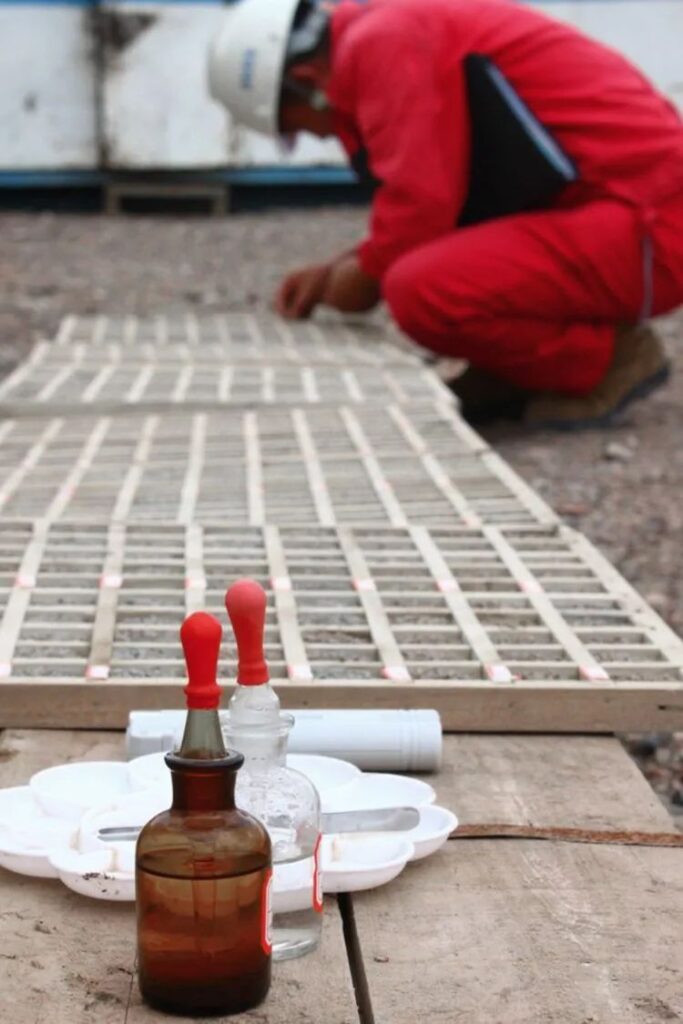Cuttings logging
1. Concept
Cuttings are rock fragments (usually called sand samples) that are brought to the surface with drilling fluid after the underground rock is broken under the action of the drill bit. Cuttings logging is to extract the broken cuttings of the drill bit according to the design requirements, and to understand the lithology and master the Downhole stratigraphic sequence, preliminary understanding of the whole process of formation oil-gas-water condition.
Cuttings logging plays a very important role in the process of petroleum exploration and development. It has the advantages of low cost, fast speed, timely understanding of underground conditions, and strong data system. It can obtain a large number of strata, structures, source-reservoir-caprock combination relationships It is a logging method widely used in my country at present.
①Definition—Fetch the broken cuttings of the drill bit according to the design requirements, and through the systematic observation, analysis and description of the cuttings, combined with various data such as drilling time, gas measurement, fluorescence, drilling fluid and electrical measurement, to understand the lithology and master the underground formation Sequence, a preliminary understanding of the formation of oil-gas-water conditions, known as cuttings logging.
Late arrival time—the time difference between the time when the stratum is drilled and the time when the underground objects are continuously returned to the wellhead
Cycle week—the time it takes for the drilling fluid to travel from the wellhead to the bottom of the well to the surface
Downtime == Drilling Tool Inner Volume / Displacement
T delay == T weeks — cutting late arrival time under T == T delay + T delay
Sand fishing time == drilling time + T delay + T delay (T delay should be checked when changing the pump)
②, cuttings logging process:
Measured lateness time – take samples according to the design spacing – wash samples – drying samples – loading samples – description – picking samples – sorting and storage
③Description method: spread out large sections, look for macroscopically, look at color from a distance, check lithology near, and combine dry and wet. When referring to drilling, focus on describing oil and gas properties.
Rock cuttings naming method:
Lithology name == color + oil and gas grade + special inclusions + lithology
The oil-bearing grades of clastic rocks are divided into:
Core (grade 6): oil-saturated, oil-rich, oil-soaked, oil-spotted, oil-stained, fluorescent
Cuttings (grade 5): oil, oil immersion, oil spot, oil stain, fluorescence
The oil-bearing grades of carbonate rocks are divided into three grades: oil-bearing, oil-spotted and fluorescent
Second, the calculation method of late time
The lateness time refers to the time difference between the time when the drilling reaches the formation and the time when the underground objects continuously return to the wellhead. The unit is min. The lateness time is divided into the lateness of drilling fluid and the lateness of cuttings. There are three calculation methods: theoretical calculation method, actual measurement method and Special lithology method.
1. Theoretical calculation method (volume method)
The calculation formula is:
T delay=V/Q=л(D2-d2)H/4Q
Among them: T late—drilling fluid late arrival time (min)
Q—Drilling fluid displacement (m3/min)
D—wellbore diameter (ie drill bit diameter m)
d—outer diameter of drill pipe (m)
H—well depth (m)
V—wellbore annular space volume (m3)
2. Actual measurement method
Operation process: When receiving a single piece, put the cellophane and white porcelain chip indicator into the drill pipe, and record the pump-on time and wellhead return time. The time difference between the two is the cycle time of the indicator, and the indicator will follow the drilling from the wellhead. The time when the fluid passes through the drill pipe and reaches the bottom of the well is called the down time, and the time when the indicator returns from the bottom of the well to the wellhead vibrating screen along the annular space with the drilling fluid is called the up time, that is, the late time.
T late = T cycle – T down
Among them, the downlink time T = (c1+c2)/Q (unit: min)
c1—Internal volume of drill pipe (l)
c2—inner volume of drill collar (l)
Q—displacement (l/min)
Usually T delay refers to the late arrival time of drilling fluid. The late arrival time of cuttings should be based on T delay plus its lag time T lag, namely: cuttings late arrival time T rock = T lag + T lag
Using the actual measurement method to calculate the lateness time requires that the target layer be measured once every 50m, and the non-target layer is generally measured once every 100m, and the actual measurement can be encrypted according to the specific situation.
3. Special lithology method
It is a method of using special lithology to correct the late time in practical work, such as sandstone, limestone and dolomite interlayers in large sections of mudstone. Due to the obvious drilling time of special lithology, it is different from the drilling time of mudstone. It can be used to correct the late arrival time. For example, record the fast drilling time of sandstone, observe and record the sandstone return time in front of the wellhead vibrating screen, and the time difference between the two is The value is the late arrival time of cuttings at the depth of the well. Using the obvious oil and gas display can also correct the late arrival time of the drilling fluid, that is, record the drilling time of the oil and gas layer and the gas measurement display time.
3. Cuttings collection and finishing
1. Removal of cuttings
①、Sampling time = drilling time + cuttings late arrival time
When the pump is changed during the logging process, the late time should be corrected. There are two correction methods:
a The time of changing the pump is earlier than the time of drilling to the sampling depth, and the new late time is calculated by the inverse ratio method:
T new = (Q original / Q new) * T original
Tnew — the late arrival time of new cuttings (min)
T original – original cuttings late arrival time (min)
Qnew—new displacement (l/min)
Q original – original displacement (l/min)
New sand fishing time = drilling time + new late arrival time
b. The time for changing the pump is later than the time for drilling to the sampling depth, and earlier than the time for sand fishing:
Correction time = (Q original / Q new) * △t
△t—the difference between the sand fishing time before changing the pump and the time of changing the pump
New sand fishing time = variable pump time + correction time
②Sampling spacing: The sampling interval and spacing shall be implemented according to the drilling geological design.
③Sampling location:
Generally, continuous sampling is carried out before the vibrating screen. If the sand sample is very small or the cuttings are powdery before the vibrating screen, a baffle should be added to the overhead groove for sampling to prevent leakage.
④Sampling method:
a Time of placing the basin and receiving samples: add the late arrival time of cuttings from the time of starting drilling.
b. Slicing sampling: Since there are too many cuttings in the sampling basin, in order to facilitate cleaning and ensure the continuity of the sample, the dichotomy and quartering methods are usually used for sampling, that is, half or one quarter of the cuttings in the basin are cut vertically. Parts, but it is absolutely forbidden to take only the upper or lower cuttings.
c. Sampling quantity requirement: no less than 1000g per bag with sampling task, 500g without sampling requirement.
d Under special circumstances, if the sand sample in the well is not fully returned, it should be replenished when the drilling fluid is circulated to the bottom of the next drilling. The sand samples taken from the depth are combined into one bag.
2. Washing, bagging and storage of sand samples
The removed cuttings should be slowly put into water for cleaning and stirring, and then poured slowly after standing for a while to prevent the suspended fine samples and lighter substances from being washed away. The cleaned sand samples should be cooled (dried) in different compartments according to the sampling order, and the depth mark should be placed to prevent the sample order from being messed up. The sand sample table should be cleaned, and its upper left corner should be placed horizontally.
After the sand samples are dry, they should be packed in bags and filled with rock chips cards. The samples that are required to be sampled should be divided into two bags, one bag will be stored as the original data after description, and the other bag will be used for sample selection and will not be stored. The bagged sand samples shall be loaded from the upper left corner to the lower right corner of the cuttings box according to the depth of the sampling well, from shallow to deep. According to the design or Party A’s requirements.
4. Factors Affecting Cuttings Logging
Mainly include well depth, late arrival time, drilling fluid performance, displacement, bit type, drilling parameters, drilling or reaming operations, rock properties, and some other human factors.
5. Description of cuttings
1. The basic method is summarized as:
Large sections are spread out, macroscopically searched in detail, color at a distance, lithology at close range, and combination of dry and wet. When drilling for reference, focus on oil and gas displays and special lithology.

2. The naming principle:
Lithology name = color + oil and gas grade + special inclusions + lithology
Such as: light gray fluorescent argillaceous siltstone
The oil-bearing grades of clastic rock debris are divided into five grades: oil-bearing, oil-immersed, oil-spotted, oil-stained, and fluorescent.
The oil-bearing grades of carbonate rocks are divided into three grades: oil-bearing, oil-spotted and fluorescent.
3. Matters needing attention when describing
①The description of the cuttings should be based on the actual cuttings, and the color, oil content, composition, sorting, roundness, and percentage content of the cuttings should be systematically observed.
② When referring to the drilling and gas survey data, the top boundary should be chased upward, and the bottom boundary should be named by layers. Oil-bearing cuttings and special lithology should be sampled in time, and unidentifiable lithology should be sampled in time for thin section identification.
③ The principle of stratification is described according to the appearance of new colors, new components, and the change of percentage content of different lithologies, and comparative analysis, with 0.5m as the minimum unit of stratification.
④Dry and wet cuttings should be respectively subjected to fluorescent wet light, dry light, drip light or carbon tetrachloride immersion irradiation and determine the fluorescence level.
6. Sketch of cuttings logging
The main content of the cuttings description, drilling time and other logging data are drawn on the back of the transparent square centimeter calculation paper in the order of well depth with the prescribed legends and symbols. This kind of drawing is called the cuttings logging sketch. The depth ratio is 1:500, and the lithological section is drawn by the grain size section. For the drawing format and drawing requirements, please refer to Q/ZLJ 515–1999 “Regulations on the Drafting of Field Logging Sketches”.


